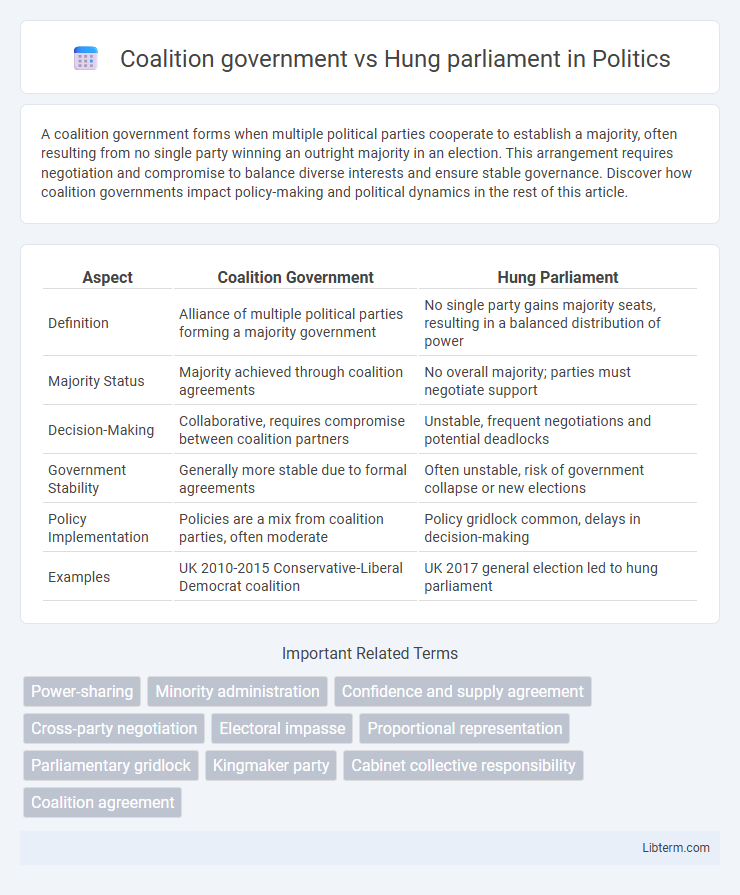A coalition government forms when multiple political parties cooperate to establish a majority, often resulting from no single party winning an outright majority in an election. This arrangement requires negotiation and compromise to balance diverse interests and ensure stable governance. Discover how coalition governments impact policy-making and political dynamics in the rest of this article.
Table of Comparison
| Aspect | Coalition Government | Hung Parliament |
|---|---|---|
| Definition | Alliance of multiple political parties forming a majority government | No single party gains majority seats, resulting in a balanced distribution of power |
| Majority Status | Majority achieved through coalition agreements | No overall majority; parties must negotiate support |
| Decision-Making | Collaborative, requires compromise between coalition partners | Unstable, frequent negotiations and potential deadlocks |
| Government Stability | Generally more stable due to formal agreements | Often unstable, risk of government collapse or new elections |
| Policy Implementation | Policies are a mix from coalition parties, often moderate | Policy gridlock common, delays in decision-making |
| Examples | UK 2010-2015 Conservative-Liberal Democrat coalition | UK 2017 general election led to hung parliament |
Definition of Coalition Government
A coalition government is formed when multiple political parties agree to cooperate, sharing power to achieve a working majority in the legislature. This arrangement involves formal agreements on policy and cabinet positions, ensuring stability and collective governance. It contrasts with a hung parliament, where no single party holds a majority, often leading to negotiation without a formal power-sharing pact.
Understanding Hung Parliament
A hung parliament occurs when no single political party wins an outright majority of seats in a legislature, necessitating negotiations among parties to form a government. This situation often leads to a coalition government, where multiple parties collaborate to achieve a majority and govern effectively. Understanding the dynamics of a hung parliament is crucial for analyzing political stability and policy-making processes in parliamentary systems.
Key Differences Between Coalition and Hung Parliament
A coalition government involves multiple political parties formally agreeing to share power and govern together, often with a signed agreement outlining policy priorities and ministerial roles. In contrast, a hung parliament occurs when no single party secures an outright majority, leading to a minority government or informal alliances without a formal coalition agreement. Key differences include the stability and clarity of governance, as coalition governments typically provide a unified executive direction, whereas hung parliaments often result in uncertain leadership and increased negotiation for passing legislation.
Causes of Hung Parliaments
Hung parliaments typically arise due to a fragmented vote distribution where no single party secures an absolute majority of seats, often caused by a multiparty system, proportional representation voting, or significant voter volatility. Electoral systems with low thresholds for entry into parliament increase the likelihood of smaller parties winning seats, thereby diluting the dominance of major parties. Regional and ideological divisions within the electorate further contribute to the emergence of hung parliaments by preventing a clear majority consensus.
Formation Process of Coalition Governments
The formation process of coalition governments involves negotiations between multiple political parties to establish a majority in the legislature after no single party secures an outright win. Parties discuss policy agreements, cabinet positions, and shared governance strategies to form a stable government. This contrasts with a hung parliament, where no party has a majority, often leading to either a coalition government or a minority government depending on negotiations and confidence agreements.
Advantages of Coalition Governments
Coalition governments offer the advantage of broader representation by combining multiple political parties, ensuring diverse viewpoints are included in decision-making processes. This collaborative approach tends to foster compromise and consensus, leading to more balanced and stable policies that reflect a wider spectrum of voter preferences. Furthermore, coalition governments enhance political stability by reducing the likelihood of abrupt policy shifts common in single-party rule, which is especially beneficial in fragmented parliamentary systems.
Disadvantages of Hung Parliaments
Hung parliaments often result in political instability due to the absence of a clear majority, making it difficult to pass legislation efficiently. The negotiation process between multiple parties can lead to compromises that dilute policy effectiveness and create government gridlock. This uncertainty can undermine investor confidence and disrupt long-term governance planning.
Historical Examples: Coalition vs Hung Parliament
Historical examples of coalition governments include the UK's Conservative-Liberal Democrat coalition from 2010 to 2015 and Germany's long-standing CDU-CSU-SPD coalitions. In contrast, hung parliaments often lead to minority governments or short-term alliances, as seen in the UK in 1974 and the Canadian federal elections of 2004 and 2006. Coalition governments typically provide more stability through formal agreements, whereas hung parliaments demonstrate political fragmentation and negotiation challenges.
Impact on Political Stability
A coalition government often enhances political stability by uniting multiple parties to form a majority, enabling more effective governance and policy implementation. Conversely, a hung parliament, where no single party secures a majority, can lead to political uncertainty, frequent negotiations, and potential governmental gridlock. The balance of power in a hung parliament often creates fragility, making stable decision-making and long-term planning more challenging.
Future Implications for Parliamentary Systems
Coalition governments often promote policy stability by fostering consensus among multiple parties, reducing legislative gridlock and enabling longer-term governance strategies. Hung parliaments, characterized by the absence of a clear majority, can lead to unstable governments and frequent elections, increasing political uncertainty and policy inconsistency. Future implications for parliamentary systems include the potential rise in coalition-building skills and negotiation tactics, which may reshape party dynamics and influence democratic resilience in multi-party landscapes.
Coalition government Infographic

 libterm.com
libterm.com